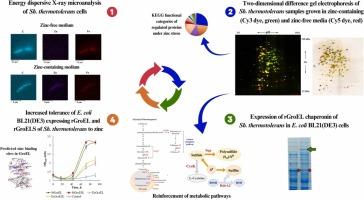Mechanisms of Microbial Hyper-Resistance to Heavy Metals: Cellular Metal Accumulation, Metabolic Reorganization, and GroEL Chaperonin in Extremophilic Bacterium Sulfobacillus thermotolerans in Response to Zinc
IF 11.3
1区 环境科学与生态学
Q1 ENGINEERING, ENVIRONMENTAL
引用次数: 0
Abstract
Mine waste disposal in dumps and stockpiles causes environmental pollution, particularly through microbe-assisted acid mine drainage (AMD) generation and groundwater contamination with hazardous heavy metal(loid)s. Metal hyper-resistance in acidophilic microorganisms remains an underexplored intriguing phenomenon. Using a multi-level approach, we provide the first data on extreme zinc resistance mechanisms in Sulfobacillus thermotolerans, recognized as one of the most metal-resistant organisms known. Under high zinc levels, Sb. thermotolerans cells exhibited efficient zinc sorption and low intracellular accumulation. Remarkably, mechanisms involved the upregulation of stress response and metabolic pathway proteins, including different GroEL chaperonin forms. Moreover, overexpression of the Sb. thermotolerans StGroEL chaperonin in Escherichia coli enhanced its growth and zinc resistance under zinc stress. 3D structure modeling and ion binding site prediction in StGroEL revealed 46 amino acid residues potentially involved in zinc docking. Thriving in natural and engineered environments, such as sulfide mines, mine waste disposal sites, and AMD, Sb. thermotolerans is a key member of acidophilic microbial communities used in commercial biotechnologies for sulfidic raw material processing. These findings, beyond their fundamental scientific relevance, have important implications for environmental protection, including AMD management, safe hazardous waste disposal, and a broader application of eco-friendly biomining technologies using metal-resistant microbial communities.

微生物对重金属的超抗性机制:嗜热亚硫酸杆菌对锌的细胞金属积累、代谢重组和GroEL伴侣蛋白
在垃圾场和库存中处理矿山废物会造成环境污染,特别是通过微生物辅助的酸性矿井排水(AMD)的产生和有害重金属(loid)污染地下水。嗜酸微生物的金属超抗性仍然是一个未被充分探索的有趣现象。采用多层次的方法,我们提供了耐高温硫杆菌极端耐锌机制的第一个数据,被认为是已知最耐金属的生物之一。在高锌水平下,耐热细胞表现出高效的锌吸附和低的细胞内积累。值得注意的是,机制涉及应激反应和代谢途径蛋白的上调,包括不同的GroEL伴侣蛋白形式。此外,在大肠杆菌中过表达耐温StGroEL伴侣蛋白,可以促进大肠杆菌在锌胁迫下的生长和抗锌能力。StGroEL的三维结构建模和离子结合位点预测揭示了46个氨基酸残基可能参与锌对接。在自然和工程环境中蓬勃发展,如硫化物矿山,矿山废物处理场和AMD,耐热菌是商业生物技术中用于硫化物原料加工的嗜酸微生物群落的关键成员。这些发现,除了其基础科学意义之外,对环境保护具有重要意义,包括AMD管理,安全危险废物处理,以及使用耐金属微生物群落的生态友好型生物采矿技术的更广泛应用。
本文章由计算机程序翻译,如有差异,请以英文原文为准。
求助全文
约1分钟内获得全文
求助全文
来源期刊

Journal of Hazardous Materials
工程技术-工程:环境
CiteScore
25.40
自引率
5.90%
发文量
3059
审稿时长
58 days
期刊介绍:
The Journal of Hazardous Materials serves as a global platform for promoting cutting-edge research in the field of Environmental Science and Engineering. Our publication features a wide range of articles, including full-length research papers, review articles, and perspectives, with the aim of enhancing our understanding of the dangers and risks associated with various materials concerning public health and the environment. It is important to note that the term "environmental contaminants" refers specifically to substances that pose hazardous effects through contamination, while excluding those that do not have such impacts on the environment or human health. Moreover, we emphasize the distinction between wastes and hazardous materials in order to provide further clarity on the scope of the journal. We have a keen interest in exploring specific compounds and microbial agents that have adverse effects on the environment.
 求助内容:
求助内容: 应助结果提醒方式:
应助结果提醒方式:


